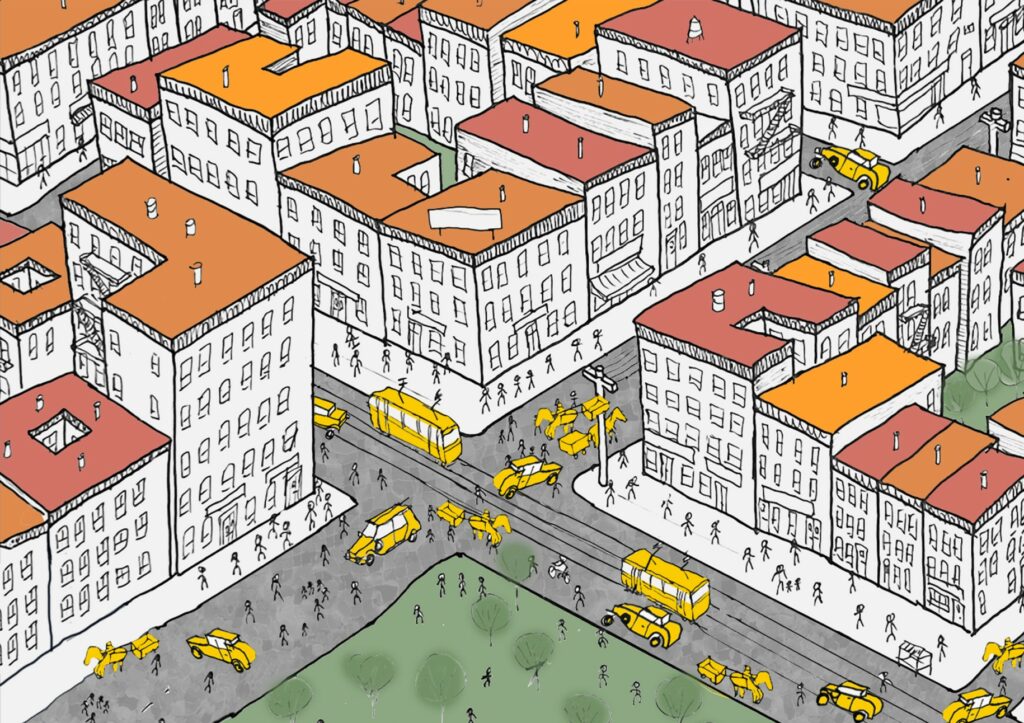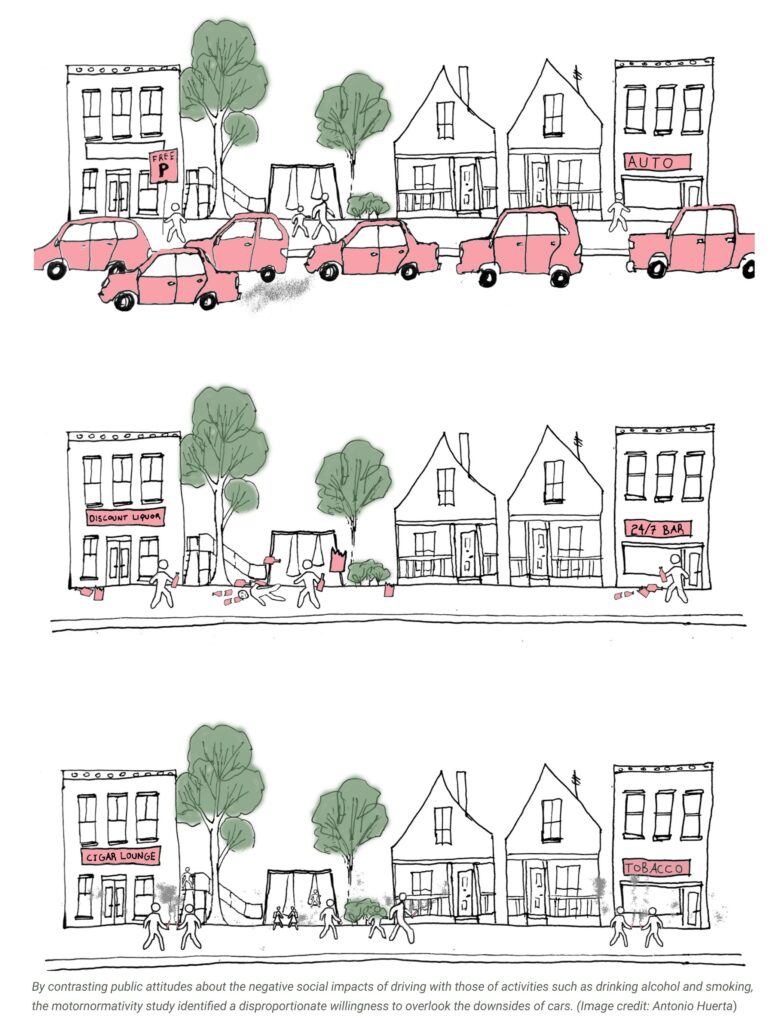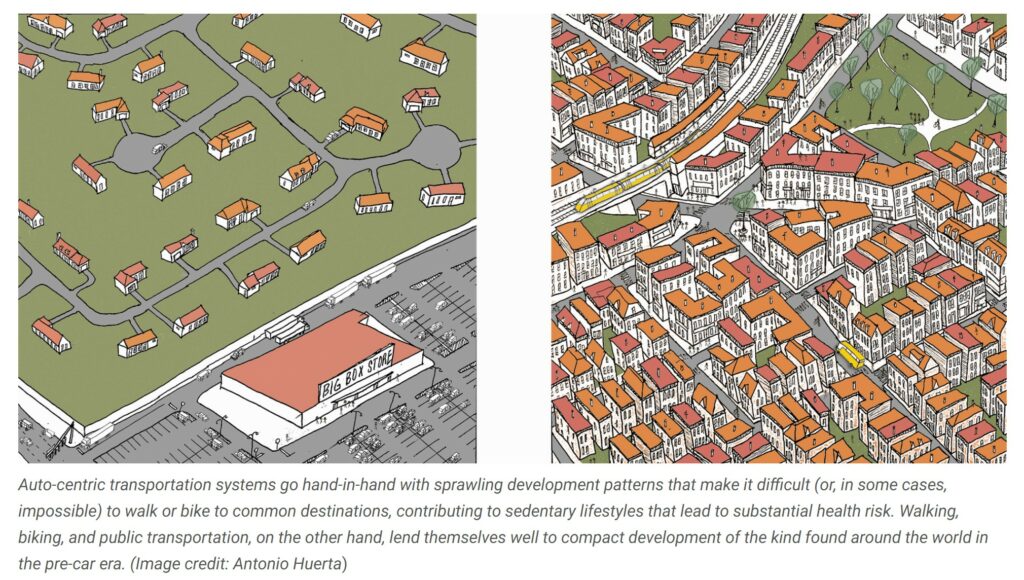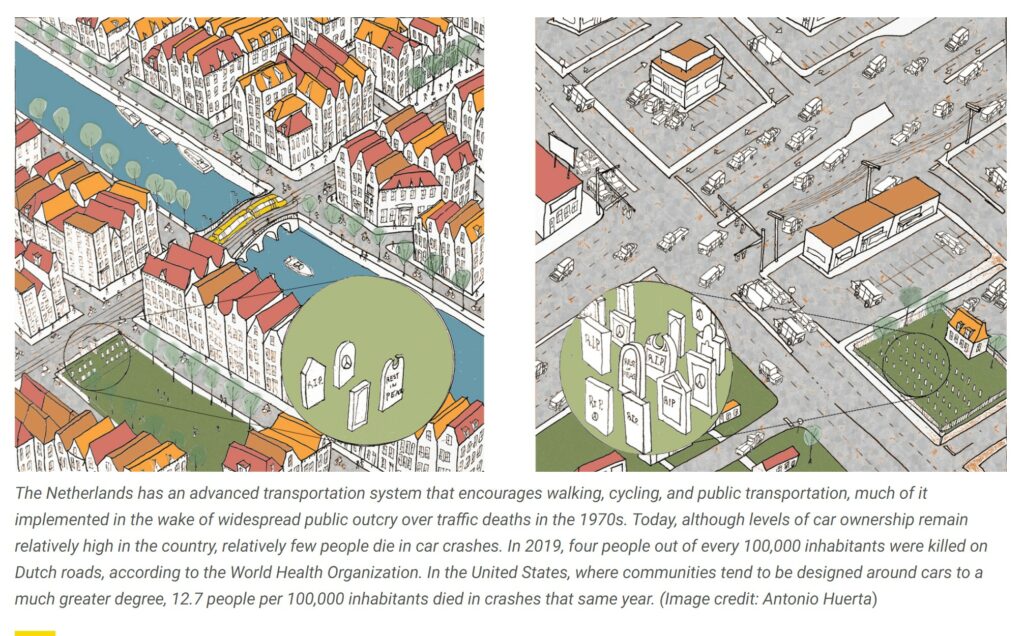Introduction: Nice piece on how Americans are so tied to their gasoline powered cars, pickup trucks, etc. and the impact on cities and environment. What is key to this article and the author’s thought is this statement: “The obvious solution … lies only in a radical revision of our conception of what a city street is for.” Where I live, the smaller city is 30 minutes away at 65 MPH (if they are doing such). If you drive faster, maybe you are there a couple of minutes sooner. There is not enough roadway to satisfy the traffic during the rush hours. Their desired solution? Add another lane each way. It doesn’t work, a waste of land, more pollution, and more fatalities and accidents. Public transportation is an after-thought. If such were
Topics:
Angry Bear considers the following as important: climate change, Hot Topics, politics, US EConomics, Yale Climate Connections
This could be interesting, too:
Robert Skidelsky writes Lord Skidelsky to ask His Majesty’s Government what is their policy with regard to the Ukraine war following the new policy of the government of the United States of America.
NewDealdemocrat writes JOLTS revisions from Yesterday’s Report
Joel Eissenberg writes No Invading Allies Act
Ken Melvin writes A Developed Taste
Introduction:
Nice piece on how Americans are so tied to their gasoline powered cars, pickup trucks, etc. and the impact on cities and environment. What is key to this article and the author’s thought is this statement:
“The obvious solution … lies only in a radical revision of our conception of what a city street is for.”
Where I live, the smaller city is 30 minutes away at 65 MPH (if they are doing such). If you drive faster, maybe you are there a couple of minutes sooner. There is not enough roadway to satisfy the traffic during the rush hours. Their desired solution? Add another lane each way. It doesn’t work, a waste of land, more pollution, and more fatalities and accidents.
Public transportation is an after-thought. If such were done, much of the issue would be alleviated. The small city has three lanes each way plus turn lanes. Crossing the streets has to be done carefully too. Similar issues are discussed in the article.
American society wasn’t always so car-centric. Our future doesn’t have to be, either, Yale Climate Connections, Sarah Wessler
Transportation is the largest source of planet-warming gases in the United States, and passenger vehicles are the top emitters within the sector. To reduce car emissions, authorities ranging from the UN to the U.S. EPA and Department of Transportation say that people need to drive less. But this message is often lost in the excitement over electric vehicles, which overwhelmingly dominate the conversation about decarbonizing ground transportation.
The heavy emphasis on car-based climate solutions seems grounded in the assumption that driving is the only realistic form of transportation in most of the U.S. and that Americans, with their innate love of car culture, wouldn’t have it any other way.
Not everyone agrees with this assessment, however. Increasingly, many policymakers, transportation advocates, and urbanists are making the case that America’s future doesn’t need to be built around the car.
A radical revision of city streets
One prominent skeptic of transportation fixes that rely solely on cars is historian Peter Norton, a professor at the University of Virginia. He has spent years working to understand the role of cars in American society — and pushing back against truisms about the national love affair with automobiles.
Early in his career, Norton’s perspective on the U.S. transportation system was fundamentally shaken by a sentence he came across in a 1920s engineering magazine. “It stopped me in my tracks — it made my pulse race,” he said. “I couldn’t believe what I was reading.”
In the magazine, editor Edward Mehren outlined a proposed remedy for the high numbers of pedestrian fatalities being seen in U.S. cities as cars became more common. Norton can still recite the core of Mehren’s argument today: “The obvious solution … lies only in a radical revision of our conception of what a city street is for.”
In the early decades of the 20th century, American streets regularly played host to a varied jumble of users, from pedestrians and cyclists to streetcar passengers, frolicking children, and horse-and-buggy drivers. But as more cars entered the picture, their high speeds created new dangers for all present.
As Norton documented in his 2008 book “Fighting Traffic: The Dawn of the Motor Age in the American City,” different groups proposed different solutions to this problem. The police focused on developing and enforcing traffic rules, with an emphasis on keeping speeds low to protect pedestrians. Schools started teaching lessons on traffic safety to help children protect themselves on roadways. But Mehren went further, offering a vision of U.S. streets in which cars were the unquestioned principal user.
Before long, this vision had become a reality in much of the nation.
The myth of America’s love affair with cars
For Norton, Mehren’s Engineering News-Record editorial was an important piece of evidence that the car-centric transportation system now found throughout the U.S. can be traced in part to a deliberate revolution led by a relatively small group of people with a personal stake in the automotive sector. (Mehren himself served as president of the Portland Cement Association, which benefited from the rapid growth of paved roads to facilitate driving.)
The question of how cars came to dominate U.S. transportation is of far more than academic interest. For Norton, lessons from the past offer a useful corrective to the idea that car-centered mobility is the only logical fit for the U.S. History is often used to legitimize the status quo, he said, and the history of transportation is no exception.
“The predominant history tells us that the status quo with car dependency is because that’s what ‘Americans’ — as if that’s a thing — have always wanted,” he said. “And what makes my jaw drop when I look back at the historical record is that that was never true … There was never a moment when lots of Americans weren’t fighting car domination.”
In “Fighting Traffic,” Norton argued that car culture was largely forced on an unwilling public by car dealers, manufacturers, automotive clubs, and others who banded together to promote automobile use, calling themselves “motordom.”
On the other side of the debate, groups including, at various points, the police, pedestrians, women, and business people took action to defend traditional uses of the street. Parents were a particularly key constituency in this group, as many of those killed by cars were children. In 1922, a parade during New York’s “safety week” featured a march by 10,000 children, 1,054 of whom were designated as a “Memorial Division” commemorating the same number of their peers who had died in accidents (mainly traffic) the year before. “White star mothers” — those whose children had perished — were also honored during the parade. Similar events occurred around the country. In 1922, Baltimore held a dedication ceremony for a 25-foot-tall memorial to the 130 children killed in accidents, many involving cars, the year before; that same year, more than 5,000 people attended a Pittsburgh ceremony honoring the 286 local children killed, many of them by cars, in 1921.
The popular discontent shown in these events doesn’t sit well with the narrative that U.S. residents have always embraced car culture. As Norton wrote in “Fighting Traffic,” “Mass demand for automobiles cannot alone explain the automotive city. Even in the United States, there is little evidence in cities in the 1920s of a ‘love affair’ with the automobile … [But] Motordom, far from leaving the future of city transportation to the natural consequences of mass demand for automobiles, fought a strenuous campaign to defend the motoring minority’s legitimacy and to redefine traffic problems.”
Pro-car bias
For Norton, the fact that the U.S. transportation sector experienced a dramatic, deliberate shift toward cars in the 20th century offers hope for a second revolution today — one that reduces the primacy of cars in American cities.
“If that sounds far-fetched, that first radical revision was incredibly far-fetched, and it was deeply resisted,” he said. “I think the best thing that we can do to make [a second shift] possible is to recognize that we need it and to recognize that [car dependency] itself is not normal, in the sense that it was the product of a deliberate effort to overturn ‘normal.’”
But recognizing that car-centered transportation is a problem worth solving isn’t always easy. Research led by Ian Walker, an environmental psychologist at Wales’s Swansea University, showed that people in car-heavy nations like the United Kingdom tend to habitually overlook the negative effects of auto-centric transportation. (The peer-reviewed study, which has been published online, is forthcoming in the International Journal of Environment and Health.)
Walker and his co-authors, Alan Tapp and Adrian Davies, developed five statements about driving behavior and risk, then developed a parallel set of statements in which a few words were changed to take cars out of the picture; for example, “There is no point expecting people to drive less, so society just needs to accept any negative consequences it causes” became “There is no point expecting people to drink alcohol less, so society just needs to accept any negative consequences it causes.” They then presented one set of the statements to more than 2,000 adults in the UK and asked them to rank their level of agreement with each; 1,053 randomly selected individuals received the car-based statements, while 1,104 got the non-car version.
When the survey results were calculated, they clearly showed that respondents were much more willing to overlook problems from cars than from other sources. In one case, just 4% of respondents strongly agreed with the statement:
“People shouldn’t drive in highly populated areas where other people have to breathe the car fumes,” while 48% strongly agreed with its nonautomotive analog, “People shouldn’t smoke in highly populated areas where people have to breathe the cigarette fumes.”
The report’s authors created a term for this pro-car bias: motonormativity.
“The way we defined motonormativity in our paper was as a shared automatic assumption that travel is fundamentally a motor activity and must remain that way,”
Walker said. Government policies that prioritize EVs at the expense of other low-carbon forms of transportation are clear examples of this kind of bias, he believes.
In the paper, the researchers note that a large-scale transition to EVs would leave many problems related to auto-centric mobility unresolved. They highlight public health as one key area of concern: Car dependency is associated with “an epidemic of physical inactivity,” they write, which significantly increases the risk of cancer, heart disease, diabetes, and strokes, among other health problems.
Car crashes present another pressing public health challenge. Road crashes kill approximately 1.3 million people globally each year, making them the leading cause of death for people aged 5 to 29. In the U.S. alone, 42,916 people died in road deaths in 2021, according to the Department of Transportation. Although this is close to the number killed by guns in the U.S. during the same year (48,830), the issue of systemic car fatalities barely registers in political debates when compared to debates over firearms.
Meanwhile, the average person receives countless messages each day reinforcing motonormativity, Walker said. “Everything from the street designs to the legal system to media reporting to film and television — all of those things push in the same direction of saying that motoring comes first and the harms of motoring are not important.”
Even less well-understood than the health risks of car-centric transportation may be the fact that, in many ways, it does a poor job of helping people go about their daily business in an efficient, pleasant, and cost-effective manner. Accepting the premise that virtually all adults need two-ton private vehicles to accompany them everywhere they go necessarily implies devoting a vast amount of space exclusively to driving and parking, leading to sprawling, inhospitable concrete landscapes. And when traffic congestion inevitably occurs, the knee-jerk solution — building more roads — often doesn’t work. Through a phenomenon known as induced demand, expanding roads simply attracts more drivers, causing new traffic jams. And as Norton documented in his 2021 book “Autonorama: The Illusory Promise of High-Tech Driving,” there’s good reason to be skeptical of promises that shared, automated vehicles, high-speed car tunnels, or other fixes promoted by the private sector can solve these problems.
A need for better choices
According to Walker, the motonormativity study was motivated by the desire to help individuals grapple with their role in perpetuating car dependency. “The reason we wanted to do it, more than anything, was, what’s the first step in handling addiction? It’s admitting you’ve got a problem,” he said. “And this was intended to get people to ask themselves that question: ‘Do I have a problem here?’”
But the point of helping people recognize their blind spots when it comes to cars isn’t to make them feel guilty about needing to drive — a condition that they probably don’t have the power to change on their own, short of moving to a less car-dependent area. A more productive goal is to help individuals demand more from policymakers and industry, pushing for transportation options that will lead to better outcomes for the planet and people alike.
Fortunately, many government officials are increasingly receptive to this idea, as seen in states like Oregon and California, where agencies are taking steps to make it easier for people to walk, bike, and use public transportation.
“One of the biggest obstacles is the message that people sometimes hear: ‘You need to drive less,’” said Norton. “I think the message that needs to be told is, ‘You need more choices.’ If we could get that message out, and if the public policy could prioritize it, that would really, really help.”
Antonio Huerta is a digital creative engaged in activism for climate change, quality urbanism, and social justice.







